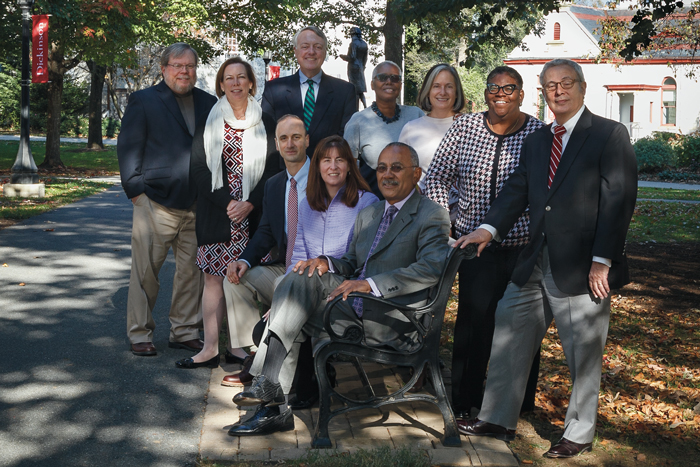President's Report 2017

Standing, from left: Robert Winston, interim provost and dean of the college; Karen Neely Faryniak ’86, chief of staff and secretary of the college; Robert Renaud, vice president and chief information officer; Joyce Bylander, vice president and dean of student life; Dana Scaduto, general counsel; Brontè Burleigh-Jones, vice president for finance & administration; Neil B. Weissman, interim president. Seated, from left: Kirk Swenson, vice president for college advancement; Stefanie D. Niles, vice president for enrollment, marketing & communications; Michael E. Reed, vice president for institutional initiatives.
State of the College
by Neil B. Weissman, interim president
Dickinson has identified “engagement” as a defining descriptor for the college. The term could not be more apt for the past academic year. Despite our current presidential transition, Dickinsonians were unusually active engaging our own community—on campus and beyond—and the wider world on many fronts. Let me offer some salient examples and invite you to explore more throughout all sections of this annual report.
The most important type of engagement for us, of course, is our students’ connection with their learning experience. Dickinson students have long been engaged with their academics and their broad range of social and residential activities. But, like students everywhere, they don’t always place their activities in broader perspective. Last year we implemented the Dickinson Four, a program to ensure that in their busy schedules students pause to reflect on the big questions that underlay their college experience. It begins with encouraging first-year students to make Dickinson their own and culminates with seniors considering how best to expand their stories as they chart their postgraduation paths. Our goal is to see that students don’t just go through the motions—even as high achievers—without fully appreciating the meaningful, useful education they are receiving. And how that education prepares them for their futures.
We have also worked to ensure that engagement characterizes every student’s experience regardless of background or perspective. I refer here to the important steps we have made toward making the college more inclusive. Many of these, such as greater emphasis on diversity in faculty recruitment, were generated by the student Why We Wear Black movement. Our dialogue has in content reflected debates on campuses across the country, but it has unfolded here with the remarkable civility that typifies Dickinson’s culture.
The theme of engagement extended beyond the campus to the wider Dickinson community. Establishing ever stronger ties with alumni, parents and friends remains a high priority for us. During the past year the ranks of virtually all of our affinity organizations—Devils’ Advocates, admissions volunteers, career mentors and the like—grew significantly. As did participation in events including Alumni Weekend and the Day of Giving. All very promising, though we have a long way to go to fully vitalize the entire Dickinson family.
Finally, we have been true to our mission of providing, in Benjamin Rush’s term, a useful education, a version of the liberal arts engaged with the wider world. Examples abound. For instance, a project by Dickinson faculty, librarians, technologists and students made materials of the Carlisle Indian School available online. A newly approved certificate in food studies places our diets in broad scientific, social and cultural context.
I do not know what Rush might have thought about the certificate (he did recommend an austere diet of “black broth of Sparta” and “barley broth of Scotland”), but his views on the centrality of citizenship to a Dickinson education were clear. In that spirit we will utilize a $650,000 grant from the Andrew W. Mellon Foundation to deepen civic engagement as a dimension of our learning experience. Funds will launch a new faculty position and underwrite faculty efforts to clearly articulate how their majors contribute to wider world activities such as internships and service.
And yes, we engaged challenges as well. Rising costs, the ongoing imperative to sustain access, and the complementary need to grow financial aid have all been subjects of past messages from me. And they remain pressing concerns to which, as you will see from the following pages, we are vigorously responding. We approach them from the standpoint of a college that maintains its vitality, even (and maybe especially) in times of transition.
Read the full President's Report.
Learn More
Published January 17, 2017